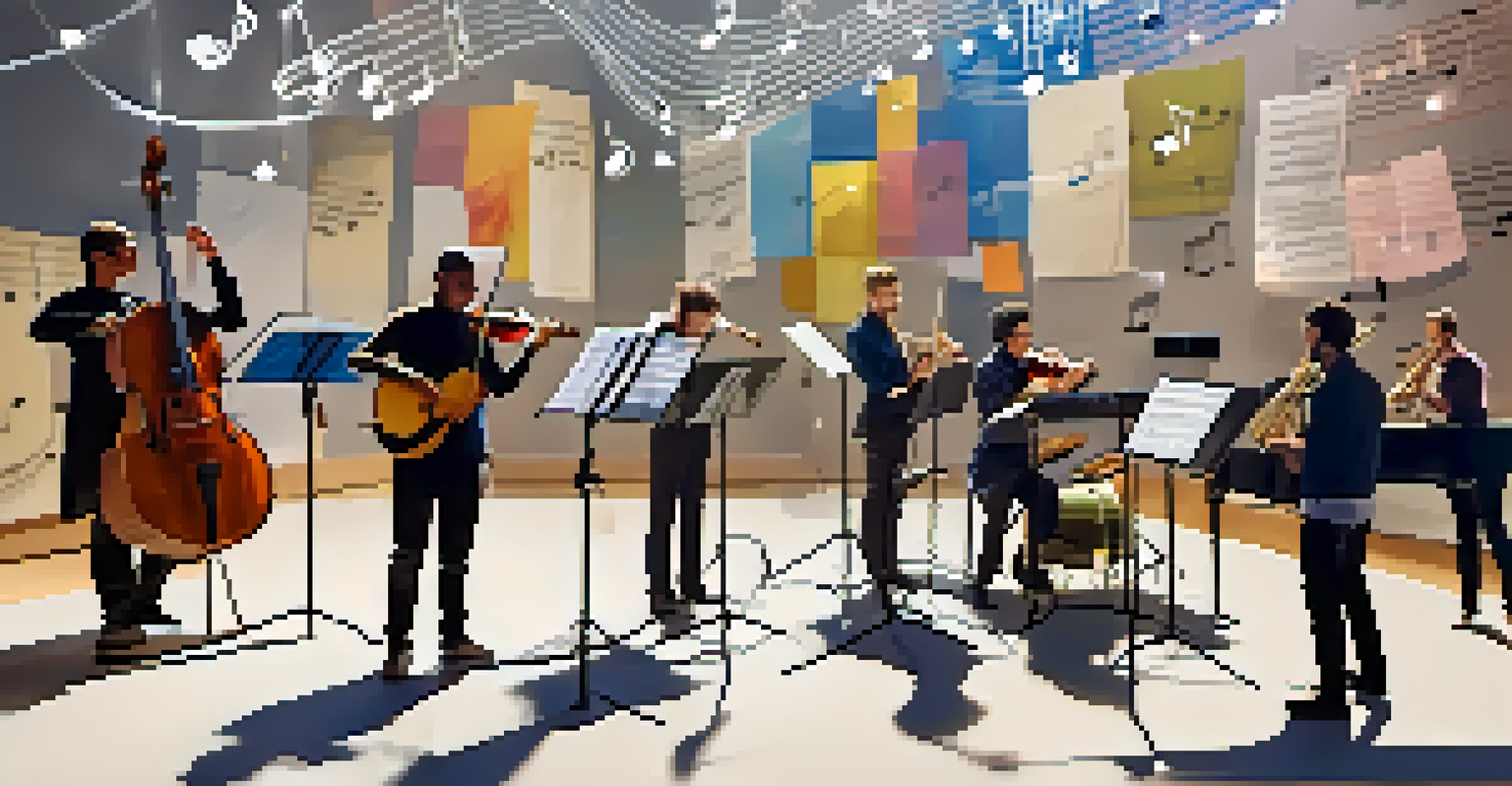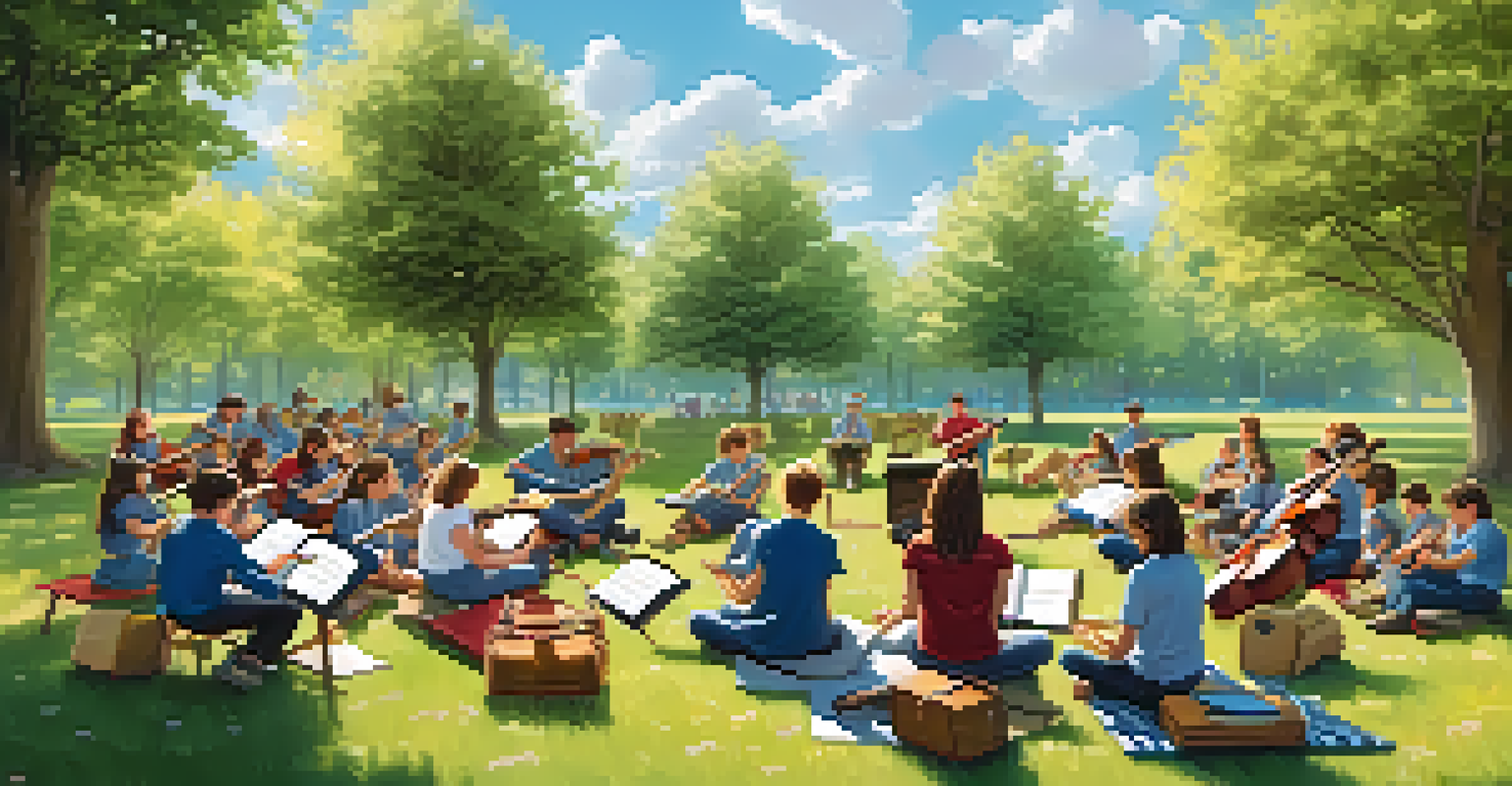The Future of Music Education: Blended Learning Approaches

Understanding Blended Learning in Music Education
Blended learning combines traditional face-to-face teaching with online resources, creating a flexible and engaging learning environment. In music education, this approach allows students to benefit from in-person instruction while also leveraging technology for practice and feedback. Imagine a student attending a weekly piano lesson but also accessing online tutorials and interactive apps to enhance their skills throughout the week.
Blended learning is the future of education, combining the best of both worlds: traditional teaching and modern technology.
This hybrid model caters to various learning styles, making music education more accessible. Some students thrive in a hands-on environment, while others may prefer the autonomy of online learning. By blending these methods, educators can create a personalized experience that meets the unique needs of each learner.
Moreover, blended learning fosters a deeper connection between students and their music. With the ability to explore different resources at their own pace, learners can discover genres and techniques that resonate with them, ultimately leading to a more fulfilling musical journey.
The Role of Technology in Music Education
Technology plays a pivotal role in the evolution of music education, enabling innovative teaching methods and tools. From music notation software to virtual instruments, these resources empower educators to enhance their curriculum and engage students in new ways. Picture a classroom where students can compose and arrange music using software that instantly plays back their creations.

Online platforms also provide opportunities for collaboration and community building among students. Musicians can connect and share their work through social media or dedicated apps, fostering a sense of belonging and inspiration. This digital connectivity can lead to exciting projects, such as virtual ensembles or collaborative performances.
Blended Learning Enhances Music Skills
Combining in-person lessons with online resources allows students to learn at their own pace and explore diverse musical styles.
While technology enhances the learning experience, it also requires educators to adapt their teaching strategies. Instructors must strike a balance between utilizing digital tools and maintaining traditional methods, ensuring that students develop both technical skills and a deep appreciation for music.
Benefits of Blended Learning for Students
Blended learning offers numerous benefits that can significantly enhance a student's musical education. First and foremost, it provides flexibility, allowing students to learn at their own pace and on their own schedule. This adaptability is particularly valuable for busy students balancing school, extracurricular activities, and personal commitments.
Technology is best when it brings people together.
Additionally, blended learning encourages self-directed learning, empowering students to take charge of their musical journey. They can explore various topics, genres, and techniques that interest them, leading to greater motivation and engagement. Imagine a student who can choose to delve into jazz improvisation online while still receiving classical training in person.
Finally, the combination of in-person and online learning fosters a more holistic understanding of music. Students can receive immediate feedback from instructors while also reflecting on their progress through online assessments and resources, creating a well-rounded educational experience.
Challenges of Implementing Blended Learning
While blended learning has immense potential, it also presents specific challenges for educators and institutions. One of the primary hurdles is ensuring that all students have access to the necessary technology and resources. Not all students have a reliable internet connection or access to devices, which can create disparities in learning opportunities.
Moreover, educators may require training to effectively integrate technology into their teaching practices. Transitioning to a blended model necessitates a shift in mindset and approach, which can be daunting for some instructors. Professional development programs can play a crucial role in equipping teachers with the skills needed to thrive in this new landscape.
Technology Transforms Music Education
Innovative tools and platforms enable collaboration, creativity, and engagement, reshaping how music is taught and learned.
Finally, maintaining student engagement in a blended learning environment can be challenging. Some students may struggle with motivation when faced with the self-directed aspects of online learning. It's essential for educators to create a supportive and interactive atmosphere that encourages participation and keeps students excited about their musical education.
Designing an Effective Blended Learning Curriculum
Creating a successful blended learning curriculum requires careful planning and consideration of various factors. First, educators must define clear learning objectives that incorporate both online and in-person components. This ensures that students understand what they are expected to achieve and how each method contributes to their overall growth.
Next, it's essential to select appropriate digital tools and resources that align with the curriculum. This could include online learning platforms, music apps, and collaborative tools that facilitate communication and feedback. A well-rounded selection of resources can keep students engaged and provide multiple avenues for exploration.
Lastly, regular assessment and feedback are crucial components of a blended learning curriculum. Educators should implement a mix of formative and summative assessments to gauge student progress and adjust their teaching strategies accordingly. This ongoing evaluation helps maintain accountability and motivates students to stay on track with their learning.
Emphasizing Collaboration in Music Education
Collaboration is a fundamental aspect of music education, and blended learning approaches can enhance this experience. By incorporating online platforms, students can connect with peers and instructors from around the world, expanding their musical horizons. Imagine a student collaborating with a musician from another country to create a unique piece that blends their cultural influences.
Group projects and virtual ensembles are excellent opportunities for students to practice teamwork and communication skills. These experiences not only foster creativity but also prepare students for real-world musical scenarios, such as band performances or studio recordings. The ability to work harmoniously with others is a vital skill in the music industry.
Collaboration Boosts Student Engagement
Working together on projects and performances fosters motivation and accountability, enriching the overall learning experience.
Furthermore, collaboration can lead to increased motivation and accountability among students. When working together towards a common goal, individuals are more likely to stay engaged and committed to their learning. This supportive environment can make a significant difference in a student's overall experience and growth.
The Future of Music Education: A Blended Approach
As we look ahead, it's clear that blended learning will play a key role in shaping the future of music education. The integration of technology and traditional methods creates a dynamic learning environment that caters to diverse needs and preferences. This evolution encourages students to take ownership of their musical journey while still benefiting from the guidance of experienced educators.
Moreover, the global reach of online resources allows students to explore a wealth of musical styles and cultures, enriching their understanding and appreciation of music. This exposure can inspire creativity and innovation, leading to the development of new genres and collaborations that transcend geographical boundaries.

Ultimately, embracing blended learning in music education can lead to a more inclusive and effective approach, preparing students for success in an ever-evolving musical landscape. By fostering a love for music and equipping learners with essential skills, educators can ensure that the future of music education is bright and full of possibilities.